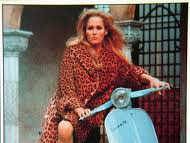The Vespa Story
 | ||||
| A Vespa poster with Ursula Andress as model |
Vespa, what comes to your mind when you hear that word? Yes, that’s right, the Italian scooter you all already know about. Vespa is a motorcycle brand from Piaggio Group , producing small motorbikes and scooters (even know they make big ones too). Firstly, before we try to learn about The History of Vespa, let us know about Piaggio.
Piaggio was founded by Rinaldo Piaggio in 1884 in Genoa, Italy. He manufactured airplane equipments, and then trains. In World War I era, Piaggio manufactured aircrafts and ships.
After World War II, Piaggio was led by Enrico Piaggio, son of Rinaldo Piaggio. At that time, Enrico wanted to make cheap and practical transportation. Enrico then asked help from Corradino D` Asciano to make the designs of the new transportation method with aircraft technology. With monoshock front suspension, and aluminium body. One day Enrico said these words “Sambra una Vespa…” means “It is like a wasp!” Enrico named the concept Vespa, which means wasp cos it looked like a wasp from above. The first prototype, called Paperino, was constructed in 1945.
By the year 1947, approx. 2500 Vespas were sold, the next year reached 10,000, and 60,000 in 1960. Vespa isn’t just sold in Italy, but also in other European countries. Vespa scooters are also sold overseas such as America, Africa, Australia, and Australia. In 1996, the company had sold about massive 16,000,000 units around the globe, including Indonesia. The massive number of sales might be caused by the company’s promotions around the world, even there is a promotional poster with Ursula Andress, a famous model from the 60s, as their brand ambassador.
The most popular variant may be the PX, which production years is more than 30 years. Actually Vespa once stopped the production in 2007, but then after some changes in engine, which now meets emission regulations, the PX model was resurrected in 2011 and is on sale again to this day. It’s rare to find a scooter with very long production span as it. The other variant maybe the 60s Vespas, which now commonly restored and become a trend. FYI, the 60s Vespa may costs above 10 million rupiahs (>$1000) in good condition and about half of it in with less good condition. About the new PX, few years ago the price tag was about 15 million Rupiahs (costs as the same as Japanese brand 125cc cub motorbikes). Now, in Indonesia a new PX costs Rp. 60 million, about 5 times more than it was years ago.
As for today, Vespa new models such as LX, MP3, the scooter with 3 wheels, GTS,and the S. The newest model launched in 2013, called 946, a scooter with unique retro-futurist design.
No exact fact when did Vespa entered Indonesian market for the first time, but the fever started to triggered when the government gave the Garuda Contingent the Italian scooters as present. Their scooters had distinctive copper plates. The superior officers were given green VGLB 150cc Vespas, and yellow VGLB 125cc Vespas for the lower officers. They were also given certificates that certified the scooters were from the government. The scooters were called ‘Vespa Kongo’, and made of high-quality German steels. The popularity of the Italian Wasp increased ever since. People started to buy a lot of them and that boosted the scooter’s popularity. In the first years, Vespa scooters were known for their practicality and were known more for their economic fuel consumption that other brands at that time
It’s interesting to know about the of Vespa in Indonesia. Vespa is widely known among the people. Kids will say “it’s a Vespa!” event though that scooter is without Vespa emblem and the Vespa decal.
Clubs, and owners group numbers are growing over time. Also, in Indonesia, Vespa riders are known for their friendliness and hospitality. For example, if you are riding a Vespa, then you meet other Vespa rider on the street, they may give you a salute or just waving hands to you. It often happens even if you meet them for the first time, which you don’t know who the person might be. That proves the solidarity and tolerance between the Vespa riders. No common thing that is, only some riders do it and this is just one of few. FYI,Vespa is also related to Aprillia, Gilera, Moto Guzzi, and Derbi. If you have one of those wave us a hand, please...
 |
| One of Vespa's best sellers, Vespa 150 Super. Production year 1965-1979. |
Vespa scooters will always be rolling on the street, no matter if the time goes by. They’ll stay in their aficionados’ hearts. It is as the tagline for Vespa Excel “ In 20 years, other motorcycles will become junk irons, but Vespas are still on the road.” There maybe many other bikes on the street, but they may be changed after years. Not for Vespa, they will always there ever after. I subjectively think that the legendary tagline, quoted from Mr. Nuradi “Lebih Baik Naik Vespa” or “It’s better to ride Vespa” is right.
There is one more thing I want to say. VESPA IS NOT A KIND OF MOTORCYCLE !! Vespa is a trademark of Piaggio Italia, a company that produces SCOOTERS. IT IS TOTALLY WRONG if you say
: "dia pergi dengan motor jenis vespa''
If the objects said to ride a Vespa, it should be :
"dia pergi dgn skuter bermerk Vespa"-
I would like to say it because there are a lot of wrong uses f the word “vespa” as an object in sentences. Some people ignore this little yet meaningful detail.
That would be all I can present. Inform me or give a correction for inaccuracy in facts.
sources : nashville247.tv, wikipedia, etc.









